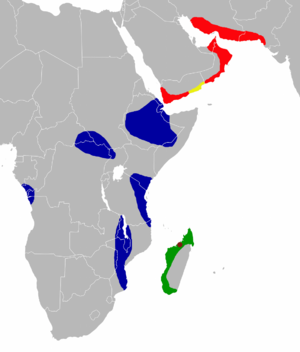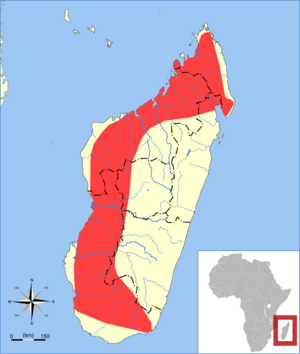Triaenops menamena facts for kids
Quick facts for kids Triaenops menamena |
|
|---|---|
 |
|
| Skull of Triaenops menamena | |
| Conservation status | |
| Scientific classification | |
| Genus: |
Triaenops
|
| Species: |
menamena
|
 |
|
| Distribution of Triaenops menamena (in green) and other species of Triaenops | |
 |
|
| Triaenops menamena range | |
The Triaenops menamena is a type of bat that lives on the island of Madagascar. You can mostly find it in the drier parts of the island. Until 2009, this bat was called Triaenops rufus.
Scientists later found that name was wrong for the Madagascar bat. Triaenops rufus actually refers to a bat from the Middle East. The Triaenops menamena is often found in forests, but it can live in other places too. These bats often sleep in large groups called colonies. They mostly eat insects like butterflies and moths. This bat is not considered to be in danger. It lives in many places and can handle changes to its home.
This bat is a medium size. Males have a forearm length of 50 to 56 mm (2.0 to 2.2 in). Females are a bit smaller, with forearms 46 to 53 mm (1.8 to 2.1 in) long. Their fur can be reddish-brown or gray. It is usually darker than other similar bats found in Madagascar. The bat's skull has a noticeable bump around its nose. It also has a special way of making echolocation calls. These calls average 94.2 kHz, which helps scientists easily identify the species.
Contents
What's in a Name? The History of Triaenops menamena
In 1881, a scientist named Alphonse Milne-Edwards described two new bat species. He thought they were from Madagascar. These bats were named Triaenops rufus (reddish) and T. humbloti (gray). Later, scientists debated if these were truly different species.
In 1994, Karl Koopman thought Triaenops rufus might be the same as Triaenops persicus. This bat lives in the Middle East and mainland Africa. Most scientists, however, still thought they were different.
Discovering the True Identity
In 2006, Julie Ranivo and Steven Goodman studied the Triaenops bats from Madagascar. They found that bats called "Triaenops rufus" from Madagascar were very similar to each other. Three years later, they made an important discovery. The original bats Milne-Edwards described as Triaenops rufus and T. humbloti were not from Madagascar. They were more like the Middle Eastern T. persicus.
It turned out that the person who collected the bats, Léon Humblot, had also visited Somalia and Yemen. Goodman and Ranivo realized he likely collected those bats there. The location was then wrongly recorded as Madagascar. So, the names rufus and humbloti could not be used for the Madagascar bat. Goodman and Ranivo gave the Madagascar species a new name: Triaenops menamena. The name menamena means "reddish" in the Malagasy language. This refers to the bat's fur color.
Family Tree of the Triaenops Bats
Triaenops menamena is one of four living species in its group, the genus Triaenops. In 2009, other scientists separated some bats into a new group called Paratriaenops. This new group includes two other bat species from Madagascar. There was also an extinct species, Triaenops goodmani, found in Madagascar.
Scientists have studied the history of these bats. They found that Triaenops menamena might have arrived in Madagascar from Africa. This could have happened about 660,000 years ago. Other studies suggest it might be more closely related to bats from the Middle East. This means it could have come from there or northeastern Africa. This split might have happened much earlier, around 4 million years ago.
What Does Triaenops menamena Look Like?
| Sex | n | Total length | Tail | Hindfoot | Ear | Forearm | Mass |
|---|---|---|---|---|---|---|---|
| Male | 28 | 90–104 | 27–38 | 6–9 | 14–17 | 50–56 | 8.2–15.5 |
| Female | 67 | 86–98 | 28–39 | 6–9 | 12–17 | 46–53 | 6.6–11.5 |
| Measurements are in millimeters (except weight in grams) and in the form "minimum–maximum". | |||||||
The Triaenops menamena is a medium-sized bat. Its fur color can be reddish-brown to gray. It is larger and darker than some other bats in Madagascar. Compared to other living Triaenops species, it is smaller than T. persicus and T. afer. However, it is a bit larger than T. parvus.
Nose and Ears
This bat has a special nose structure called a noseleaf. It has three pointy parts, like a trident, on the back part of its noseleaf. The two outer points are shorter and curved. The middle one is longer. Its ears are small and wide. They have small cuts on the inside.
Body and Wings
The bat's fur is soft and silky. The hairs on its body are about 5 to 6 mm long. Its wing membranes are dark and you can see through them. The end of its tail usually sticks out from the tail membrane. Males are usually a little bigger than females. The bat's wingspan is about 270 to 305 mm (10.6 to 12.0 in).
Skull and Teeth
The bat's skull has a well-developed front part, called the rostrum. It has a clear bump around the nose area. The cheekbones are strong. The top of the skull has a small ridge. The lower jaw has a rounded process at the back.
Its upper front teeth have two points. The upper canine tooth has three points. The front upper premolar tooth is pushed outside the line of other teeth. This means the teeth in front and behind it touch. The first lower front tooth has two points, and the second has three.
Echolocation Calls
You can easily tell this bat apart by its echolocation calls. The call has a steady sound part, then a short part with changing sound. Each call lasts about 6.5 to 13.5 ms. The average time between calls is 42.7 ms. The loudest part of the call is at about 93.2 kHz.
Where Does Triaenops menamena Live and What Does It Eat?
The Triaenops menamena mostly lives in the dry western parts of Madagascar. However, it has also been found in wet areas in the far southeast and northeast. It can live up to 1300 m (4300 ft) above sea level. It mainly lives in forests, but it can also be found outside of them. It does not completely depend on forests to survive.
This bat always lives in caves. It is known to sleep in very large groups. One cave colony was thought to have over 40,000 bats! This same cave also had about 10,000 other bats called Paratriaenops furcula.
Diet
Lepidoptera (butterflies and moths) are the main food for this bat. But it also eats Coleoptera (beetles) and Hemiptera (bugs). It eats smaller amounts of other insects too. Scientists are still trying to understand how this bat and the Paratriaenops furcula bats share their living space. Both eat moths and live in the same areas.
Is Triaenops menamena Endangered?
The IUCN Red List says this species is of "Least Concern". This means it is not considered threatened. It is common and lives in many places. It can also handle changes that humans make to its home. This is true even though some of its forest homes are being destroyed.
This bat has been found in many protected areas. Sometimes, bats are hunted for food in southwestern Madagascar. This bat is sometimes caught by accident during these hunts.


